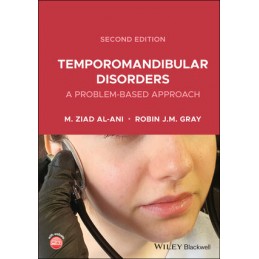- Reduced price

Order to parcel locker

easy pay


 Delivery policy
Delivery policy
Choose Paczkomat Inpost, Orlen Paczka, DHL, DPD or Poczta Polska. Click for more details
 Security policy
Security policy
Pay with a quick bank transfer, payment card or cash on delivery. Click for more details
 Return policy
Return policy
If you are a consumer, you can return the goods within 14 days. Click for more details
A valuable resource on how to diagnose and treat temporomandibular disorders (TMD)
The newly and thoroughly revised 2nd Edition of Temporomandibular Disorders:: A Problem-Based Approach delivers a systematic and logical approach to diagnosing and treating temporomandibular disorders.
Using a case-based approach to assist readers with understanding and retention, the book discusses the practical realities of managing patients and promoting effective treatment of temporomandibular disorders. Containing full colour clinical images and diagrams throughout, the chapters include practical guides on how to make splints and samples of patient information sheets which can be used as templates. Readers will get access to topics such as::
Perfect for undergraduate dental students and general dental practitioners, the new edition of Temporomandibular Disorders is also useful to postgraduate dental students, academics, and researchers.
Data sheet
Preface to the Second Edition ix
Acknowledgements xi
About the Companion Website xiii
1 About the Book 1
About temporomandibular disorders: what is a ‘TMD’? 1
About the book 2
Chapter 2: Clinical aspects of anatomy, function, pathology, and classification 3
Chapter 3: Articulatory system examination 3
Chapter 4: I’ve got ‘TMJ’ 3
Chapter 5: I’ve got a clicking joint 3
Chapter 6: I’ve got a locking joint 3
Chapter 7: I’ve got a grating joint 3
Chapter 8: You’ve changed my bite 4
Chapter 9: I’ve got pain in my face 4
Chapter 10: I’ve got a dislocated jaw 4
Chapter 11: My teeth are worn 4
Chapter 12: I’ve got a headache 4
Chapter 13: I’ve got whiplash 4
Chapter 14: What’s of use to me in practice? 5
Chapter 15: You and the lawyer 5
Chapter 16: The referral letter 5
Chapter 17: How to make a splint 5
Chapter 18: Bruxism: Current knowledge of aetiology and management 5
Chapter 19: Splint therapy for the management of TMD patients: An evidence-based approach 5
Chapter 20: Patient information 6
Appendix I: Flowcharts 6
Appendix II: Glossary of terms 6
Appendix III: Short answer questions 6
2 Clinical Aspects of Anatomy, Function, Pathology, and Classification 7
The joint anatomy, histology, structure, capsule, synovial membrane, and fluid, ligaments 7
The intra-articular disc (meniscus) 11
The bones of the temporomandibular joint 15
Mandibular (jaw/masticatory) muscles 16
Classification and Pathology 25
Diagnoses of TMDs 29
Further Reading 31
3 Articulatory System Examination 32
Examination of the temporomandibular joints 32
Mandibular (masticatory) muscle tenderness 39
Further Reading 50
4 I’ve Got ‘TMJ’! 52
History 52
Examination 53
Special tests 55
Differential diagnosis 55
Management 56
5 I’ve Got a Clicking Joint 64
History 64
Examination 65
Other special tests 67
Treatment 74
The patient journey 79
6 I’ve Got a Locking Joint 82
History 82
Examination 1 83
Diagnosis 85
Treatment 86
TMJ locking 88
Conclusion 90
7 I’ve Got a Grating Joint 91
Examination 91
Diagnosis 92
Treatment 92
Final treatment plan 95
8 You’ve Changed My Bite 101
History 101
Examination 104
Treatment 104
Discussion 106
Conclusion 111
Further Reading 112
9 I’ve Got Pain in My Face 114
History 114
Examination 115
Differential diagnosis 116
Treatment 121
Questions to ask patients regarding pain in general 122
Further Reading 123
10 I’ve Got a Dislocated Jaw 125
Examination 126
Likely diagnoses 126
Management 127
11 My Teeth Are Worn 132
History 132
Examination 133
Diagnosis 135
Treatment 135
Important considerations in tooth surface loss 136
Further reading 147
12 I’ve Got a Headache 148
Examination 149
Radiographs 149
Articulatory system exam 150
Likely diagnosis 151
Management 153
Patient journey 154
Further Reading 155
13 I’ve Got Whiplash 156
Examination 157
Record-keeping 158
Are TMD and whiplash related? 159
Likely diagnosis 161
Management 161
14 What’s of Use to Me in Practice? 164
Counselling and reassurance 165
Drug therapy 165
Physiotherapy 166
Splint therapy 168
Mouth prop 171
Occlusal adjustments 171
Does orthodontic treatment cause TMD? 175
Restorative treatment, the dentist, and TMD 176
The use of a facebow and semi-adjustable articulators 177
Radiographs 178
Further referral 178
15 You and the Lawyer 182
Case scenario 1: note and record-keeping 182
Case scenario 2: a medical report request 185
Case scenario 3: a disgruntled patient 188
Further Reading 191
16 The Referral Letter 192
Details 192
History 192
Request 194
Further Reading 194
17 How to Make a Splint 195
How do you make a stabilisation splint? 195
Fitting a stabilisation splint 205
How do you make an anterior repositioning splint? 211
Bite registration 213
Further reading 217
18 Bruxism: Current Knowledge of Aetiology and Management 218
Aetiology of bruxism 218
Definition of bruxism 219
Bruxism and TMD 220
Why bruxism (parafunction) is potentially damaging? 221
How much evidence about the efficacy of botulinum toxins on bruxism? 221
How can bruxism be managed? 222
Further reading 223
19 Splint Therapy for the Management of TMD Patients: An Evidence-Based Discussion 224
Stabilisation splint (SS) 225
Anterior repositioning splint (ARPS) 228
Mandibular advancement/snoring appliances 231
20 Patient Information 235
Stabilisation splint 235
Anterior repositioning splint 236
Use and care of occlusal bite splint 236
General advice for patients with a TMD 238
Exercise programme for patients with TMD 239
Appendix I Flowcharts 241
Appendix II Glossary of Terms 253
Further Reading 274
Appendix III Short Answer Questions 275
Index 277
Reference: 98330
Author: Niklaus P. Lang
Reference: 98337
Author: Len Tolstunov
Reference: 52825
Author: Patrick J. Bradley
Reference: 57799
Author: Giovanni Felisati
